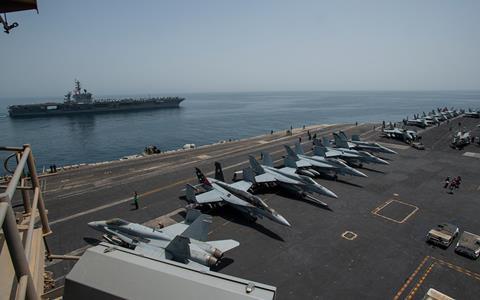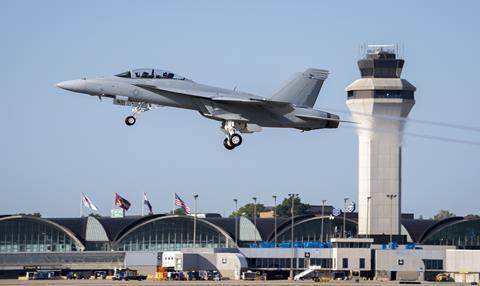After a lengthy dispute with the Pentagon, Boeing has secured a production contract for the US Navy’s (USN’s) final new-build F/A-18E/F Super Hornet fighters.
The deal, announced by the Pentagon on 19 March, covers five single-seat F/A-18E and 12 two-seat F/A-18F fighters under production lots 46 and 47.
All 17 aircraft will be delivered in the latest Super Hornet Block III standard. Delivery of the new fighters is scheduled to begin in the winter of 2026, according to the navy, with the final handover no later than spring 2027.
Worth some $1.3 billion to Boeing, the contract is seemingly the final order for new-build F/A-18 fighters destined for the USA.
“We are ready to build and deliver these final Block III F/A-18 Super Hornets to the US Navy over the next few years,” Boeing says.
Notably, the latest order will allow the aerospace giant to extend F/A-18 production into 2027. Boeing had previously forecasted it would shutter the St Louis, Missouri assembly line in 2025.

That prospect at one point appeared unlikely, with no overseas orders materialising and navy officials seeking to avoid an additional US order in 2023.
Over the navy’s objections, Congress inserted funding for 20 new Block III Super Hornets into the 2022 and 2023 defence budgets. After more than a year of negotiations, Boeing and the USN reached agreement.
Partially at issue was ownership of technical data related to Super Hornet sustainment, to which the navy had been seeking to gain access. The 17-aircraft order apparently resolves that impasse.
“The technical data package was a crucial part of this negotiation,” says Rear Admiral John Lemmon, the navy’s program executive officer for tactical aircraft. “It is necessary for naval aviation’s operational readiness and post-production sustainment”, he adds.
Boeing also praised the agreement, which is a major boon for the airframer.
“Years of hard work by a lot of people went into getting this deal done,” the company says. “Our team created and finalised a contract that is right for Boeing and right for the war fighter.”
The additional two years of production will give Boeing new opportunities to secure overseas customers for F/A-18s, which could extend the life of the twin-engined jet.
The fourth-generation, carrier-capable fighter makes up the bulk of the USN fleet, with some 420 F/A-18E/Fs in service at the start of 2024, according to Cirium data. The US Marine Corps still operates 140 older model F/A-18A/C/Ds, Cirium says.
The navy also operates a smaller fleet of EA-18G Growler electronic warfare jets, which are based on the Super Hornet airframe.
By contrast, the USN only plans to acquire 273 carrier-capable Lockheed Martin F-35Cs, according to Lockheed.

Although the navy is acquiring the F-35, and developing a sixth-generation platform called F/A-XX, the service still expects to operate large numbers of F/A-18s for decades to come.
”The Super Hornet remains a predominant aircraft in the carrier air wing and will continue to provide significant combat capability into the 2040s,” Lemmon says.
“Super Hornet is the front-line, go-to workhorse,” Boeing says. “We have seen that play out in the news this year,” the company adds, referencing repeated combat missions flown by USN F/A-18s over the Middle East in recent months.
Even if new production ends in 2027, Boeing will continue to generate revenue on sustainment work for the sizeable F/A-18 fleet.
The jet is considered one of most affordable modern fighters to buy and operate.
Boeing is in the process of upgrading the navy’s existing Super Hornets to the latest Block III standard. Improvements include increased service life, a new large-area touch-screen cockpit display, reduced radar cross section and a more powerful computer processor.
Block III F/A-18 airframes are certified for 10,000 flight hours, versus 6,000h for Block II-configured jets.































